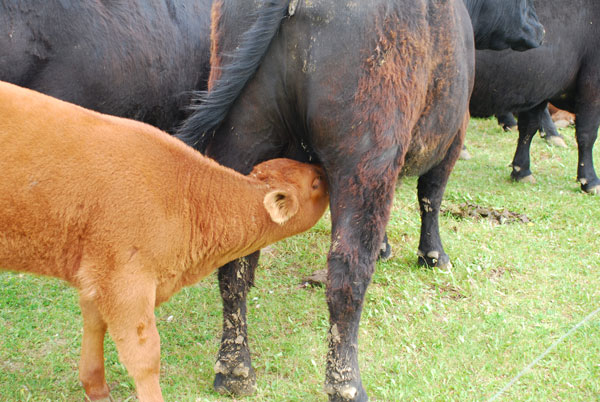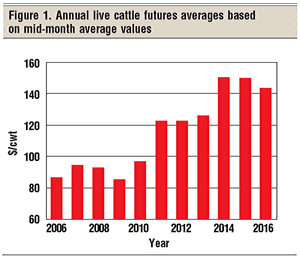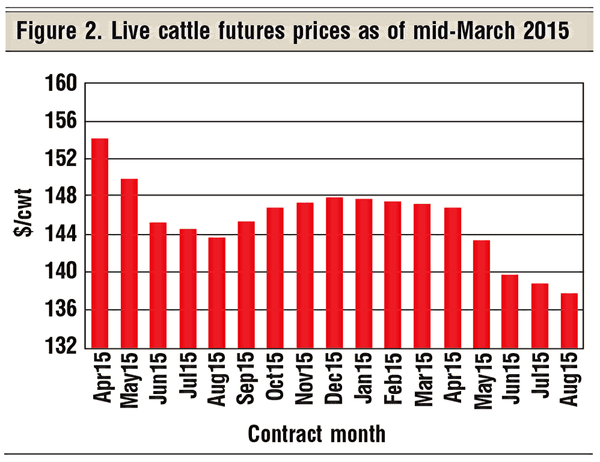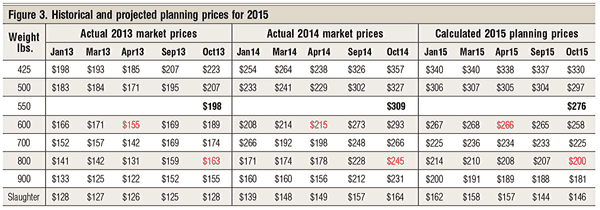
Feeder cattle market prices have thus far stayed relatively strong, albeit a little lower than the October 2014 peak. While markets typically overreact on both the upside and the downside, the bottom line for ranchers is that prices thus far in 2015 are very strong relative to previous years. Ranchers’ biggest challenge is to make sure they take advantage of these good times, as these prices likely won’t last through this decade.
Over the next two years, ranchers need to keep two general price characteristics in mind. First, is the absolute level of beef prices. Second, is the relative price of different weights of feeder cattle, which I call “buy-sell margins.”
Buy-sell margins make or break post-weaning enterprises. Yes, cost of gain is important, but most ranchers have that under reasonably good control.
In this month’s column, I’ll focus on the absolute price level. Next month, I’ll focus on the relative price levels that will determine backgrounding, stocker cattle and cattle feeding profits.

70+ photos showcasing all types of cattle nutrition
Readers share their favorite photos of cattle grazing or steers bellied up to the feedbunk. See reader favorite nutrition photos here.
Ranchers who sell calves at weaning should focus on the absolute price levels. I predict that ranchers selling at weaning will do well in 2015 and 2016.
Meanwhile, those who grow out their calves, or run grass cattle, should focus more on the relative price of feeder cattle. Post-weaning enterprises function around the relative prices of feeder cattle, and I predict the price situation for these will be greatly different in 2015-16 versus 2009-14.
The 2009-15 trend line in my feeder cattle futures data shows a positive $20 annual trend, but I don’t see this continuing. Those growing their calves, grazing yearling steers and retaining ownership may see a couple of challenging years ahead, as cattle prices level off and adjust downward in a return to more historical cattle price cycles.
My advice for ranchers is to always compare their marketing alternatives to selling at weaning. You need to know if you’re making your profit by running cows, or growing and finishing your calves. To do this, you must price your calves at weaning — whether you sell them or not. Using beef cow profits to subsidize cattle feeding is not a good economic decision.
If you want to generate a quick review of the absolute feeder cattle market price levels, go to Kansas State University’s beefbasis.com. Go to the third page and generate a “Stocker Index” for your state. Click on the small graph symbol on the stocker index, and you’ll find a gold mine of data for graphing stocker cattle price trends for your state. This software allows you to pick a state and generate several stocker price charts for that state. The price data graphs come from USDA’s Agriculture Marketing Service summary of weekly sale barn prices for that state.
I routinely use this program to gain a quick feel for stocker price averages over several time periods up through the current week’s prices. For example, using beefbasis.com, I plotted monthly stocker prices from mid-February 2015 to mid-March 2015. It clearly signaled a run-up in stocker prices in the first half of March.
I used another option in the beefbasis.com program with an Oklahoma rancher who was trying to decide when to market his stockers on wheat pasture. He was considering grazing his current steers to heavier market weights rather than buying expensive replacement stockers. He decided to take his current steers well beyond 850 pounds and is now looking to market them in April 2015. He used the beefbasis.com analysis program with Oklahoma data rather than the Nebraska data that I used.
 It’s important to keep current prices in perspective with previous prices. I like to look at the one-year chart on beefbasis.com to see current prices relative to prices over the last year. For instance, researching seven-day averages for Nebraska stocker prices (average of 350 to 650 pounds) for the last year indicates that weekly prices peaked in October 2014, but current prices are still high relative to early 2014 and prior to that.
It’s important to keep current prices in perspective with previous prices. I like to look at the one-year chart on beefbasis.com to see current prices relative to prices over the last year. For instance, researching seven-day averages for Nebraska stocker prices (average of 350 to 650 pounds) for the last year indicates that weekly prices peaked in October 2014, but current prices are still high relative to early 2014 and prior to that.
Let’s now consider the live cattle futures market prices, along with current absolute price levels of finished cattle (Figure 1). Figure 1 depicts the strong run-up in slaughter cattle prices since 2010. It also suggests the 2015 average could be similar to 2014, but I predict the monthly trend to be opposite that of 2014. I base this projection on the current live cattle futures prices presented in Figure 2.

Figure 3 shows my current suggested planning prices for five key marketing periods in 2015. It projects 600-pound steers on grass at $266 in spring 2015 and off grass at 800 pounds in fall 2015 at $200, with a –$66 buy-sell margin. In 2014, the buy-sell margin for grass cattle was a +$30, and it was also positive in 2013. Yes, times are a-changin’. The red numbers in Figure 3 are marked specifically for grass cattle marketings.
The fall 2015 planning prices (Figure 3) generate a profit projection of $541 per cow for my eastern Wyoming and western Nebraska study herd. This compares to $602 per cow in 2014. It’s projected that the unit cost of producing 100 pounds of steer calf on this study ranch in 2015 will be $173 compared to $194 in 2014. Replacement costs and lower hay costs account for this cost difference. Replacement costs for 2016 are projected to be considerably higher.

I fully expect ranchers who sell calves at weaning will have another near-record, high-profit year in 2015 — down only slightly from 2014.
Harlan Hughes is a North Dakota State University professor emeritus. He lives in Kuna, Idaho. Reach him at 701-238-9607 or [email protected].
You might also like:
60+ stunning photos that showcase ranch work ethics
Q&A: Nutrition author says dietary recommendations are shockingly unscientific
Don't bid away future profits by overpaying for cows
Pricklypear control helps replenish pastures
6 steps to low-input cow herd feeding
10 negative reviews of the Food Babe worth reading & sharing
About the Author(s)
You May Also Like


.png?width=300&auto=webp&quality=80&disable=upscale)

.png?width=300&auto=webp&quality=80&disable=upscale)
